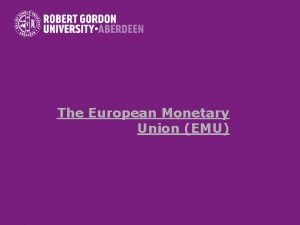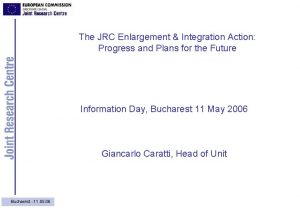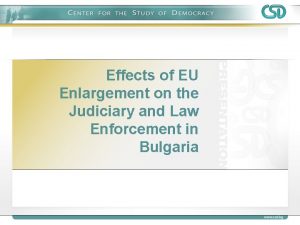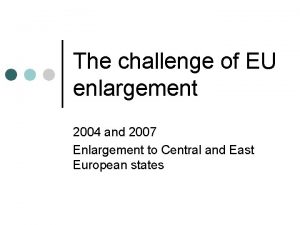6 th IZAASE Workshop on EU Enlargement and























- Slides: 23

6 th IZA/ASE Workshop on EU Enlargement and the Labor Markets n BULGARIAN LABOUR ISSUES AND LABOUR MOBILITY TO THE EU Prof. D. Sc. Rossitsa Rangelova Economic Research Institute Bulgarian Academy of Sciences Bucharest, 25 -26 November 2013

Basic points: - Bulgaria was among the most concerned countries in the Balkan region regarding the socio-economic crisis in the 1990 s in terms of the so-called push factor. - People in Bulgaria are strongly inclined to emigrate. The experience of the country is indicative of migration trends and specificity from and in the Southeastern Europe, which could provide reliable implications for useful conclusions and an adequate migration policy both in the national and the international perspective.

Regarding participation of migrants in foreign labour markets, three basic groups can be divided: n n n those who are connected with the 'brain drain' phenomenon legal labour migrants and illegal migrants Two main types of migration channels can be distinguished: permanent migration, and temporary, including circulation. The paper is focused on the legal labour migrants, for which the differences evolve mainly from professional specificity.

BULGARIA: Scale of migration Period - year Number 1989 218 000 (8 981 000) 1990 -1992 252 000 1993 -2000 221 000 Total 1989 -2000 691 000 Total 1989 -2005 716 000 (7 761 000)

Government’s estimates on the number of Bulgarian immigrants by country, 2008 n n Destination country USA Spain Greece n n n n United Kingdom Germany Italy Canada Austria Total number Number of immigrants from Bulgaria Around 200, 000 Over 120, 000 Around 110, 000 (non-official 200, 000) Over 60, 000 Over 50, 000 Around 45, 000 Around 25, 000 Around 700, 000

Today Bulgaria remains among the main n migrant sending countries in the EU. The global financial and economic crisis has severely affected Bulgaria this has led to a sharp increase in numbers of emigrants since 2009 while there is no clear evidence of return migration (as theoretical rules and past practices show).

Bulgaria: External migration - total, 2007 -2012 (number), NSI 2007 Immigrants in the country 1, 561 Emigrants Migration from the increase country 2, 958 -1, 397 2008 1, 236 2, 112 -876 2009 3, 310 19, 039 -15, 729 2010 3, 518 27, 708 -24, 190 2011 4, 722 9. 517 -4, 795 2012 14, 103 16, 615 -2, 512

It is indicative that parents in Bulgaria n strongly encourage their children to migrate. Nearly 90% of the persons surveyed by the NSI in 2001 declared that they encourage their children to study or work abroad. The percentage of people urging their children to resettle abroad is lower than the proportion of those who push them to study or work abroad, but nevertheless it remains very high - nearly 55%.

Possible positive effects of migration in sending countries: • Inflow of remittances benefiting receiving individuals and countries n • Emigration may reduce unemployment in some sectors n • Investments from diasporas and returnees n • Improvement of human capital of migrants / returnees n

Possible negative effects of migration in sending countries: n • Loss of highly skilled workers followed by reduced growth and productivity n • Reduced quality and availability of essential services (e. g. medical and social services, education) n • Labour force withdrawal by migrant family members receiving remittances

Possible negative effects of migration in sending countries: Progressive ageing and increased dependency ratio n • Neglected care for children and elderly left behind n • Lower school performance and enrolment of children left behind n • Family disintegration n

Basic demographic indicators, 2012 Population - to 31. 12 (thousand) Share of urban population (%) 7 284. 6 72. 9 Crude birth rate 9. 5 Crude death rate 15. 0 Rate of natural increase - 5. 5 Total fertility rate 1. 50

Age structure of the population in Bulgaria, 2011, Total=100, % Total Male Female Under working age* At working age** 14. 1 14. 9 13. 4 62. 9 67. 0 57. 5 Over working age*** 17. 2 14. 7 19. 6 * Under 15 years of age ** For male - from 16 to 62; for female - from 16 to 59 *** For male - 63 and over; for female - 60 and over.

Projection of the population number by age in Bulgaria, young (0 -14) and old people (65 and over), 2003 -2050

Population structure in Bulgaria by ethnical groups, 2011, Total=100% Total In the towns In the villages Bulgarians 84. 8 90. 3 70. 0 Turkish Roma Other Not identified 8. 8 4. 9 4. 6 3. 7 20. 6 8. 1 0. 7 0. 8 1. 0

Labour market issues n n Large-scale emigration of mainly young and active people led to declining number of the labour force in Bulgaria. Migration is likely to affect individual sectors of the economy differently, which contributes to distortion of the production structure and economic activity in the country, and generates imbalances in some sectors such as health care sector, as out-migration of doctors and nurses is a key challenge for the country.

In Greece n Bulgarians constitute the second largest nationality after Albanian migrants. Female emigrants predominate and migration is most likely individual. Bulgarians occupy niches in the labour market, mainly in agriculture and tourist services. Seasonal workers coming from the region of the Rhodopes Mountain in Bulgaria cross the border to work in Western Thrace in Greece.

In Spain n the emigrants are mostly men and migration is most likely family-based. The first is the husband who arrives and afterwards the relatives join him. In Spain Bulgarians work in various service activities like: hotels and restaurants (15. 9%), household/family activities (14. 5%), and other public or personal service activities (13. 9%); agriculture (12. 2%), construction (11. 1%), transport, storage and communication (9. 4%). The shares of men and women, working as low skilled workers are similar (25. 2% and 22. 2% respectively). About 23% of the Bulgarian migrants were unemployed in 2011, of which 64% are men and 36% are women. This level of unemployment is considerably higher compared to that before their departure from Bulgaria.

Level of unemployment in Bulgaria, 15 years and over, 1990 -2012, %

Policy responses in Bulgaria n Until recently and even now the policy of the Bulgaria’s officials and the public opinion looks like rather encouraging emigration, i. e. forcing the push factor than attracting people to live and work in their own country.

Policy responses in Bulgaria The successful future of this policy is not in the retention of human capital in Bulgaria, but in promoting its development via or during migration abroad and taking advantage of it in the country. n In spite of the efforts undertaken by the national authorities, there are still no specific and sufficient services in place for people who return. n

Policy responses in Bulgaria n A common feature of the current Bulgarian migration policy remains the substantial number of strategies, action plans, programs, etc. but they have pure declarative character and the lack of goals set out in them with indicators for the achievement of actual results.

Thank you for your attention.
 Job enrichment example
Job enrichment example Cause of splenomegaly in malaria
Cause of splenomegaly in malaria Lumbar enlargement
Lumbar enlargement Lvh criteria cornell
Lvh criteria cornell Job analysis steps
Job analysis steps Enlarge a shape
Enlarge a shape Centre of enlargement
Centre of enlargement Describe fully a single transformation
Describe fully a single transformation Absorptive atelectasis
Absorptive atelectasis Left atrial enlargement ecg
Left atrial enlargement ecg Aortic valve anatomy
Aortic valve anatomy Contoh job rotation adalah
Contoh job rotation adalah Symptoms of thyroid problems
Symptoms of thyroid problems Enlargement drawing
Enlargement drawing How to enlarge a shape by scale factor 2
How to enlarge a shape by scale factor 2 Eu enlargement timeline
Eu enlargement timeline Tule river spillway enlargement project
Tule river spillway enlargement project Posterior white column
Posterior white column Derivation of chezy formula
Derivation of chezy formula Enlargement of the eu
Enlargement of the eu Eu enlargement
Eu enlargement To describe enlargement you must give
To describe enlargement you must give Describe fully the single transformation
Describe fully the single transformation 9-7 similarity transformations
9-7 similarity transformations












































